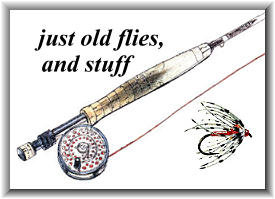The Fledermouse is mainly a late evening and night fly.
It is at its best from the time the bats put in their
first appearance over the water and on into the night.
That is how it received the name "Fledermouse." The
pattern was conceived one rainy morning in August at
Wade Lake, Montana. In its first season it was used
over a period of six weeks for about three hours every
evening. It proved to be a knockout.
[Two paragraphs omitted.]
Now for the tying of the Fledermouse. I doubt if
there is a more simple pattern to make. Try hook
sizes one, two, or three, standard length and wire.
I have even used No. 4 in 4X long shank, which really
makes a mouthful. Secure your thread to the hook
shank at the start of the bend. There is no tail
so that eliminates all chance of fouling up that
part of the fly. The body is muskrat fur, under
hair and guard hairs combined. It is the guard
hairs sticking out from the body that give it
that tufted appearance. Don't pull them out.
It takes about three clumps of hair to make a body.
To define a clump of hair? It's roughly the amount
you can get hold of between thumb and index finger.
Next, cut three clumps of muskrat fur off the piece
of skin and lay them on your tying table, or on your
leg, as I prefer to do it.
The fly is now as good as tied. Take hold of the
tying silk you have already secured to the hook;
lay the left index finger across the silk about
four inches from the hook; then carry the silk
around and over the finger back to the bend of
the hook, and spiral the silk forward to within
one-eighth inch of the eye of the hook. Make half
hitch. You now have a four inch loop of tying silk
attached to the hook just at the bend where you
would tie on the tail if the pattern called for
one. Your left index finger is still in the loop,
holding it taut. Pick up the first clump of hair,
holding it by the butts, and center it in the open
end of the loop, then slide it down through the
loop to the shank of the hook.
Take the second clump, insert in loop as before
and slide down to within half an inch of the first
clump. Now space the third and last clump of hair
half an inch from the second clump. Now, with the
thumb and forefinger of the right hand, take hold
of the open end of the loop bringing the two strands
of silk together. With the left hand attach hackle
pliers to loose end of loop.
Keeping the loop taut, spread the hair evenly for
about two inches between the strands of silk. Revolve
the hackle pliers until you twist what resembles a
rough, furry strand of chenille about two inches
long. Wrap this around the shank of the hook
almost to the eye, and tie it off. Tie on a grey
squirrel tail wing, and you have a Fledermouse.
Tying time approximately two to three minutes.

